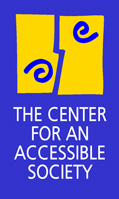
DISABILITY
ISSUES
INFORMATION
FOR JOURNALISTS
ABOUT
THE CENTER
Wed, 03 Sep 2003 -- Media Matters No. 35
Can everyone actually get info from your website? Not if you use PDFMore and more groups -- particularly professional groups like law firms and universities, are turning to the PDF format for information on their websites. This is a bad trend. You should NOT use PDF files on your site as the ONLY source of information. If you expect the information to actually be read, be sure to provide an HTML alternative as well.
Why? Because PDF files are overly large, bulky, and often crash computers.
In Media Matters no. 31 we looked at how journalists use websites. A study conducted by Jakob Nielsen's web usability firm showed that, contrary to what one might think, not all journalists sit in newsrooms with high-speed internet access at their fingertips. "Many journalists are freelancers or work from home, typically using slow dial-up connections," noted Nielsen. "Many also have old computer equipment and do not feel an obsessive need to download all the latest software." PDF files often "actually crashed the journalists' computers," he pointed out.
HTML is the format of choice for websites. Stick to it, and you won't have to worry about these problems.
PDF files remain virtually inaccessible to people who cannot visually process graphic files -- which are what Adobe PDF's are. Although there is an Abobe site that allows one to convert the PDF to a text file (go to http://www.adobe.com/products/acrobat/access_simple_form.html and type in the URL of the PDF to get it as text), that conversion tool can do only so much. If the PDF file is in columns, for example, the text conversion is likely to give a reader the first line of each of 3 columns, followed by the second line of each of the 3 columns, and so on.
The Adobe corporation, the software maker who created the PDF format, relentlessly pushes PDFs as a solution, stressing that they will retain their "look." Because they are essentially graphics files, they can't be tinkered with by anyone. This appeals to designers, but it's bad for communication online.
PDF files are "typically big, linear text blobs that are optimized for print and unpleasant to read and navigate online," says Nielsen. "PDF is good for printing, but that's it." Nielsen explains in more detail the problems with using PDF to present online information at http://www.useit.com/alertbox/20030714.html
Contact us at info@accessiblesociety.org